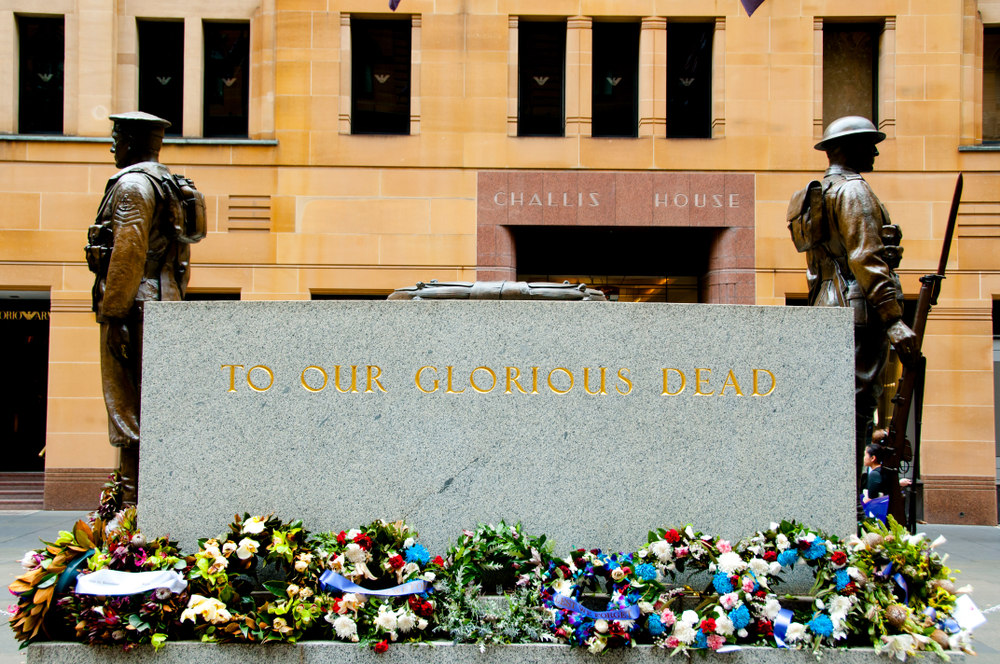Share This Article
By Sahar Adatia and Jimmy Singh.
In the early hours of Sunday 25 November 2018, a 20-year-old man allegedly climbed on top of the Martin Place Cenotaph, committing an offensive act on a war memorial.
According to NSW Police, at about 3am, it is alleged that the man entered the commemorative site and then mounted the memorial. He was then photographed with the statues, all of which was captured on CCTV cameras.
Police from Sydney City Police Area Command were soon to arrive and arrested the man, who is from Jarrahdale in Western Australia.
He was then taken to Day Street Police Station where he was handed a Field Court Attendance Notice for commit offensive act at war memorial.
The man is due to appear at the Downing Centre Local Court next month.
Another Attack on The Cenotaph: Intoxicated Man Pours Beer on Soldier
It is not the first time the Martin Place Cenotaph has been a target of an offensive act.
In August 2018, in what could only be described as a drunken disgrace, a man was charged with defacing the Cenotaph after he poured beer over the feet of the statue of one of the soldiers.
Just before 9:30pm on August 9, CCTV cameras captured the 43-year-old man approaching the war memorial in a drunken state.
He removed flowers from a wrath and placed them in the soldier’s hands, then positioned a cigarette lighter in his left arm along with a cigarette on the rifle, before pouring beer on the soldier and walking away.
Shortly after the incident, the man was arrested near Castlereagh Street and taken to Day Street police station. He was charged with committing an offensive act on a war memorial, and wilful damage or defacing of a protected place.
At the time, NSW Premier Gladys Berejiklian wrote on Twitter, “An attack on any war memorial is an attack on Australian values and the heroic legacy of our veterans”.
The Significance of The Cenotaph
Located between George and Pitt Street in Martin Place, the Cenotaph is a place of memorial. It depicts larger than life sculptures of servicemen who operated in World War I.
Specifically, the eastern sculpture is of an infantryman from Gallipoli, Private William Pigot Derby, while on the western end stands a Royal Australian Navy signalman, John William Varcoe. Both are portrayed realistically, wearing their uniforms and carrying weapons.
The statues stand in the ‘at ease’ position, portrayed to be guarding the Cenotaph. On top of the altar sits a bronze wreath. The servicemen each face a flagpole approximately 3 metres from the monument.
The Cenotaph is of historical importance for its embodiment of collective grief representing the loss of life by Australian servicemen in World War I.
Furthermore, its historical significance also holds for its role in inaugurating the ‘Dawn Service’ on Anzac Day in 1929, the year it was opened, which symbolises a tradition now observed on Anzac Day throughout Australia.
According to the NSW Office of Environment and Heritage, unlike the majority of other war memorials in Australia, the Cenotaph does not name individuals, underscoring the meaning of the word itself, which translates to ‘empty tomb’.
Instead, the Cenotaph mourns and commemorates the communal sacrifice of lives defeated at war. It is for this reason that the monument is both representative and rare as a respected war memorial.
Along with it serving a historical association with those who lost their lives at war and those who have mourned them, the Cenotaph also holds social magnitude as a powerful focal point for memorial services in NSW associated with all wars and conflicts.
Actions That Might Constitute Damaging or Desecrating Protected Places in NSW
In NSW, it is an offence to damage or desecrate protected places.
Under the offence, people are prohibited from vandalising, damaging or defiling any shrine, statue or memorial that is situation in a public area.
Along with the Martin Place Cenotaph, examples of such protected areas include the sculptures of Anzac Memorial Hyde Park and the statue of Queen Victoria that is found at the Queen Victoria Building on George Street in Town Hall.
If a person breaks, vandalises, damages, urinates on, or in some other way defiles a public monument, then they can be charged with this offence and face a criminal conviction.
The Law on Damaging or Desecrating Protected Places in NSW
Anyone that is guilty of damaging or defacing a ‘protected place’ will face a fine of up to $4,400 and a criminal conviction.
Anyone that is guilty of committing any nuisance, offensive conduct or indecent act in (on or in connection with) a ‘war memorial’ or ‘interment site’ in NSW will face a penalty of up to $2,200 fine and a criminal conviction. (section 8 of the Summary Offences Act 1988 (NSW)).
This offence does not carry a penalty of imprisonment.
However, despite this, while the court can impose the above pecuniary penalties, instead of imposing a fine, the court can order an offender to a Community Corrections Order which can include conditions that the offender must comply with, such as community service work, supervision, curfew conditions, and place restriction conditions under section 8 of the Crimes (Sentencing Procedure) Act 1999 (NSW).
If a person charged with this offence pleads guilty (or is found guilty after a defended hearing in court) he or she will get a criminal conviction unless the Magistrate is convinced to not impose a criminal conviction under ‘section 10 dismissal’ or ‘conditional release order without conviction’.
A ‘protected place’ includes a shrine or statue situated in a public place. It includes a war memorial or interment site.
An ‘interment site’ includes a memorial.
A ‘war memorial’ includes a war memorial situated in a public place such as Anzac Memorial in Hyde Park, Sydney, and any other place considered a war memorial, such as “a specified shrine, monument, statue or other structure or place, and a specified area within its vicinity.”
For an outline as to the meaning of ‘damage’, see our blog on ‘the law on intentionally or recklessly destroy or damage property in NSW’.
What is ‘Offensive Conduct’?
Offensive conduct includes any behaviour that a reasonable person who is either in view or hearing or near a public place (or school) will be disgusted, have his/her feelings wounded, cause anger, become outraged or cause resentment from.
The ‘reasonable person’ is assumed not to be ‘thin-skinned’.
That ‘reasonable person’ is not required to actually have been present at the time of the alleged ‘offensive conduct’.
In determining if the conduct is truly offensive in today’s community, taking into account the location and circumstances of the alleged conduct, the court will consider the ‘reasonable person’ test. (Ball v McIntyre (1966) 9 FLR 237).
Some of the defences to an offensive conduct charge in NSW include the following, which can result in the charge being dismissed:
- If the conduct was committed as an expression of a political view.
- If there was a ‘reasonable excuse’ for behaving the way alleged to be offensive. i.e. self-defence.
- You honestly, on reasonable grounds, held a belief that the alleged offensive conduct was allowed.
- You acted involuntarily due to a medical condition.
- The alleged conduct was not in a public place.
- The alleged conduct was committed as a result of duress or necessity.
Any questions arising from this blog?
Our team are available 24/7 and appear in all courts.
We have some of Australia’s leading criminal defence lawyers in Newcastle, Wollongong, Penrith, Sydney CBD and 5 other office locations in NSW.









